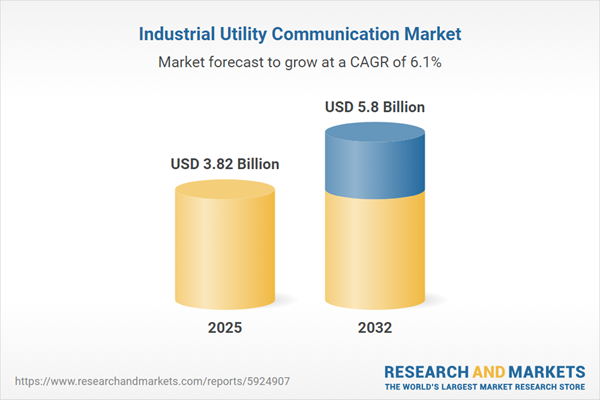Speak directly to the analyst to clarify any post sales queries you may have.
The Industrial Utility Communication Market is undergoing significant change as utilities adapt to growing infrastructure demands, evolving technologies, and heightened expectations for operational resilience. This report delivers precise, actionable insights to equip industry leaders for strategic decision-making in a competitive landscape.
Market Snapshot: Industrial Utility Communication Market Size and Growth
The Industrial Utility Communication Market grew from USD 3.61 billion in 2024 to USD 3.82 billion in 2025. With a projected CAGR of 6.10%, the market is set to reach USD 5.80 billion by 2032. This dynamic reflects a strong trajectory fueled by the adoption of advanced networking solutions and the imperative for more reliable, scalable infrastructure across global utilities.
Scope & Segmentation of the Industrial Utility Communication Market
This report systematically analyzes market opportunities, technology adoption, and competitive positioning, structured around these key segments:
- Component: Gateways, Routers, Switches, Installation Services, Maintenance Support, Communication Software, Network Security.
- Technology: Wired Communication, Wireless Communication.
- End-User: Energy & Power, Mining, Oil & Gas, Water/Wastewater.
- Region: Americas (United States, Canada, Mexico, Brazil, Argentina, Chile, Colombia, Peru), Europe, Middle East & Africa (United Kingdom, Germany, France, Russia, Italy, Spain, Netherlands, Sweden, Poland, Switzerland, United Arab Emirates, Saudi Arabia, Qatar, Turkey, Israel, South Africa, Nigeria, Egypt, Kenya), Asia-Pacific (China, India, Japan, Australia, South Korea, Indonesia, Thailand, Malaysia, Singapore, Taiwan).
- Companies: 4RF Limited, ABB Limited, Advantech Co., Ltd., Antaira Technologies Co, Ltd., AusOptic International Pty Ltd., Cisco Systems Inc., CSE Global (Australia) Pty Ltd., Eaton Corporation PLC, Fujitsu Limited, General Electric Company, Hitachi Energy Ltd., Honeywell International Inc., Huawei Technologies Co. Ltd., Mitsubishi Electric Corporation, Nokia Corporation, ORing Industrial Networking Corp., RAD Data Communications Ltd., Rockwell Automation Inc., Schneider Electric SE, Siemens AG, Telefonaktiebolaget LM Ericsson, ZTE Corporation.
Key Takeaways for Senior Decision-Makers
- Industrial utility communication networks enable real-time data sharing, driving monitoring, predictive maintenance, and automation within complex infrastructure environments.
- Deployment of digital and edge technologies is redefining how utilities manage assets and operational risks, supporting faster decision cycles and higher system uptime.
- Utilities must balance adopting next-generation platforms with the need to uphold cybersecurity standards and compliance across new and legacy infrastructure.
- Strategic partnerships and modular, software-defined networks provide flexibility to address fluctuating demand, regulatory shifts, and the integration of renewables.
- Regional differences in infrastructure maturity and policy are central to shaping both technology strategies and investment priorities for industry participants.
Tariff Impact: Navigating Sourcing and Cost Pressures
In 2025, newly imposed United States tariffs on key networking components have reshaped procurement strategies for utilities. Increased duties on essential hardware like gateways, routers, and switches have prompted many organizations to diversify suppliers, favor local sourcing, and implement open-architecture solutions. These measures aim to control total cost of ownership, manage supply chain risks, and maintain compliance with evolving regulations. By modifying vendor portfolios and forming strategic collaborations, industry participants are reducing tariff exposure and enhancing long-term resilience.
Industrial Utility Communication Market: Research Methodology & Data Sources
This analysis draws on primary interviews with technical executives, network architects, and regulatory experts, combined with comprehensive reviews of technical whitepapers, standards, and recent case studies. Rigorous validation methods and analytical frameworks have been used to cross-check findings, ensuring trends and strategic implications are substantiated and relevant for industry leaders.
Why This Report Matters
- Supports leaders in identifying actionable technology investment areas and critical operational improvements for communication efficiency.
- Enables informed sourcing and risk mitigation decisions in a landscape shaped by evolving tariffs and supply-chain complexity.
- Clarifies regional and segment-specific opportunities, aligning market strategies with regulatory and infrastructure dynamics.
Conclusion
Industrial utility communication is at a pivotal evolution point, driven by digital innovation and shifting regulatory priorities. This report offers clear, strategic perspectives to help decision-makers enhance resilience, optimize operations, and strengthen market positioning.
Additional Product Information:
- Purchase of this report includes 1 year online access with quarterly updates.
- This report can be updated on request. Please contact our Customer Experience team using the Ask a Question widget on our website.
Table of Contents
3. Executive Summary
4. Market Overview
7. Cumulative Impact of Artificial Intelligence 2025
Companies Mentioned
The companies profiled in this Industrial Utility Communication market report include:- 4RF Limited
- ABB Limited
- Advantech Co., Ltd.
- Antaira Technologies Co, Ltd.
- AusOptic International Pty Ltd.
- Cisco Systems Inc.
- CSE Global (Australia) Pty Ltd.
- Eaton Corporation PLC
- Fujitsu Limited
- General Electric Company
- Hitachi Energy Ltd.
- Honeywell International Inc.
- Huawei Technologies Co. Ltd.
- Mitsubishi Electric Corporation
- Nokia Corporation
- ORing Industrial Networking Corp.
- RAD Data Communications Ltd.
- Rockwell Automation Inc.
- Schneider Electric SE
- Siemens AG
- Telefonaktiebolaget LM Ericsson
- ZTE Corporation
Table Information
| Report Attribute | Details |
|---|---|
| No. of Pages | 191 |
| Published | November 2025 |
| Forecast Period | 2025 - 2032 |
| Estimated Market Value ( USD | $ 3.82 Billion |
| Forecasted Market Value ( USD | $ 5.8 Billion |
| Compound Annual Growth Rate | 6.1% |
| Regions Covered | Global |
| No. of Companies Mentioned | 23 |









